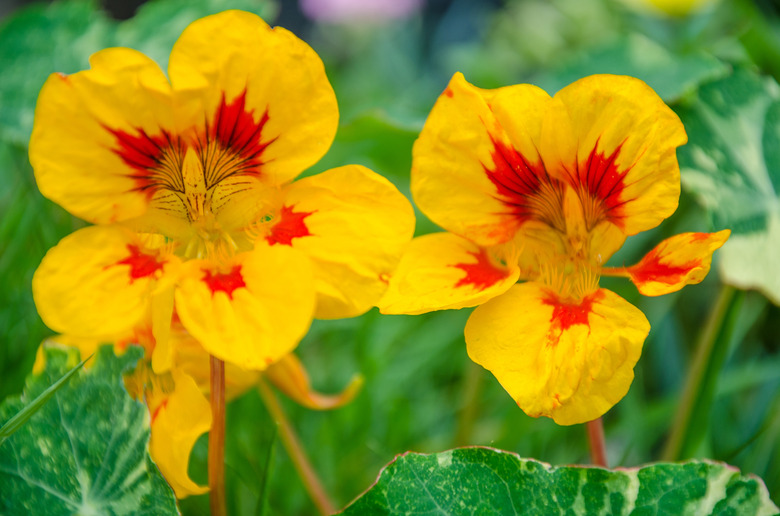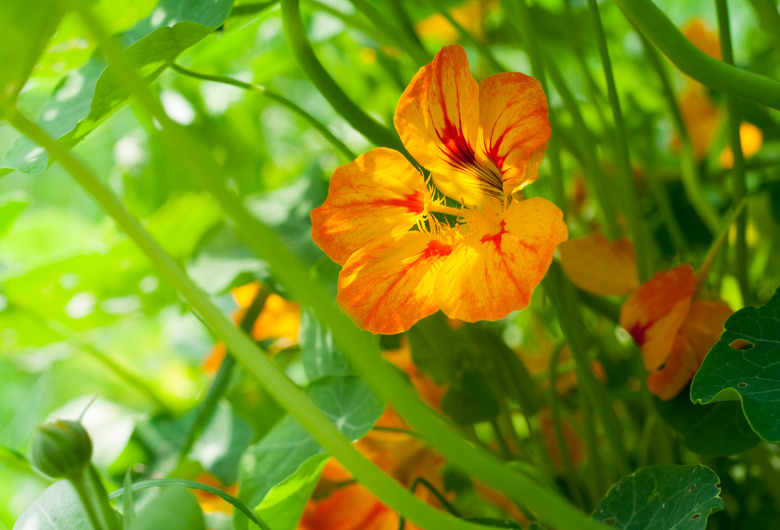How To Grow Nasturtium
We may receive a commission on purchases made from links.
Whether peeking around stones in a rock garden, spilling out of hanging baskets, or adding flair to a culinary herb garden, annual nasturtiums (Tropaeolum spp.) are steadfast, old-fashioned favorites that remain versatile garden performers in today's gardens. Once the flowers begin blooming in spring, the plants continue to produce flowers throughout the warm summer growing season.
All About Nasturiums
All About Nasturiums
Part of the versatility of nasturtiums stems from the fact that there are two primary types of nasturtiums. One has trailing stems (Tropaeolum majus), which grow to 10 feet long, and another has a more compact, mounding type of growth (Tropaeolum minus), which reaches a height less than 24 inches depending on the cultivar.
Nasturtium flowers are not only colorful in earth-tone shades of cream, yellow, orange and red but they also have a delightfully spicy fragrance. Some nasturtium flowers are single, and others are double. Because their long petioles (leaf stalks) are joined near the centers of the rounded leaves, which resemble water lily leaves, nasturtium foliage is sometimes described as resembling umbrellas or parasols.
Although most nasturtiums have solid-green leaves, look for plants in the "Alaska series" if you're partial to variegated foliage. This series features green leaves that are spotted or mottled in shades of white or cream. Tropaeolum minus 'Alaska' and 'Tip Top Alaska' are compact plants, and Tropaeolum majus 'Jewel of Alaska' has long climbing stems that extend to 8 feet.
Regardless of species and cultivar, nasturtiums are no-muss, no-fuss plants that even novice gardeners can grow with ease. You won't have to amend the soil for these low-maintenance plants or even fertilize them.
Best Uses for Nasturtium
Best Uses for Nasturtium
In the ornamental garden, nasturtium flowers are a source of vivid color over a long blooming season. Its best landscape use depends on the type of nasturtium plant you're growing. For example, if you're growing one of the shorter, compact plants, feature it in flower beds, rock gardens or landscaped borders. If you're growing one of the climbing or trailing types, feature it on a trellis or spilling out of hanging baskets or window boxes.
Both types of nasturtium can also be grown as a ground cover, and both are equally at home as part of an edible landscape design as they are in the ornamental garden. As an herb, all parts of nasturtium plants are edible except for the roots. The edible flowers and leaves add color and a peppery flavor to salads, and they also serve as a garnish for main courses or side dishes. Even the flower buds and seedpods are edible, and they're particularly flavorful when pickled and used as a substitute for capers.
As a pollinator plant, the color and shape of nasturtium flowers attract hummingbirds, making this plant a must-have for a bird-friendly garden. Naturally drawn to colors in the red-yellow spectrum, hummingbirds flock to nasturtiums. Other than their hummingbird-attracting colors, nasturtium flowers have a shape that's tailored to the long tongues of these tiny birds. Funnel-shaped spurs contain nectar made of sucrose, which is more concentrated and sweeter than glucose or fructose.
How to Grow Nasturtium From Seed
How to Grow Nasturtium From Seed
- Start the seeds in peat pots and plant the pots directly in the garden after the last spring frost and after the seedlings emerge.
- Fill the peat pots with a soilless seed-starting mix and keep the mix moist but not soggy until it's time to transplant the nasturtium seedlings.
- When planting the pots, be careful that you do not sever the delicate roots.
After the last spring frost, you can sow seeds directly:
- Sow nasturtium
seeds in the garden approximately 1 inch deep and 10 inches apart. - You
can also sow groups of two or three seeds at this recommended spacing and pinch
to remove all but the strongest seedling in each group.
Tip
The large seeds have a hard seed coat, so soaking the seeds overnight may improve germination. Even though you can sow the seeds after the last spring frost, they germinate best after the soil has warmed to at least 65 degrees Fahrenheit.
In What Zone Does Nasturtium Grow Best?
In What Zone Does Nasturtium Grow Best?
Gardeners can grow nasturtiums as an annual across USDA zones 2 through 11, although their best performance is in climates with cooler summers. When the temperatures climb in hot climates, nasturtiums may languish, and flower production may slow or cease altogether.
When Should You Plant Nasturtium?
When Should You Plant Nasturtium?
Because nasturtiums are annuals, you'll want to sow the seeds early enough to make sure plants have plenty of time to produce lots of flowers during the growing season but late enough in spring to avoid frost damage. Particularly in Northern zones with shorter growing seasons, maximizing the blooming window means first checking the calendar and marking the last expected frost date. When sowing seeds after this date, check the calendar again to see when you can expect the first flowers, which will be six to eight weeks after sowing the seeds.
If an unexpected late frost is in the weather forecast after the date that was expected as the last frost and your newly sown nasturtium seeds have already germinated, protect the tender seedlings by covering them with a floating row cover or other lightweight fabric. Secure the ends of the row cover with U-shaped landscape pins to make sure the wind doesn't blow the fabric off the seedlings. Uncover the plants the next day or whenever the temperature is warm enough to ward off frost.
Soil, Sunlight, and Water Recommendations for Nasturtium
Soil, Sunlight, and Water Recommendations for Nasturtium
Unlike many garden plants that need rich soil to perform their best, nasturtiums put a different spin on having to prepare the soil before planting because they actually prosper in poor soil. In fact, soil that's too rich or fertile may inhibit flower production at the expense of promoting lush foliage. Look around your yard for a sunny garden spot that has average to poor soil that is also slightly acidic and drains well, and that is likely the perfect spot to plant your nasturtiums.
Nasturtiums grow best in full sun except in climates with very hot summers, such as across the South. In these regions, plants appreciate being shielded from the harsh afternoon sun in a location that receives shade or filtered sun. If you grow nasturtiums in a spot that receives a lot of shade, however, flower production will be reduced.
Nasturtium plants have some tolerance for dry soils, but you'll still have to water them during periods of drought. If you're growing nasturtium for its edible leaves and/or flowers, keep the plants watered during hot summers. When the plants become stressed by the heat, the leaves and flowers have a stronger and spicier taste than when the plants are kept hydrated.
No fertilizer is necessary for nasturtiums, which is a plus for gardeners who prefer plants that need only minimal maintenance. If you plant your nasturtiums at the edge of a lawn or as an edging plant for a flower bed, remember that fertilizer from turfgrass and other landscape plants may be easily carried away from the targeted areas by rainwater or irrigation water, fertilizing unintended targets such as your nasturtiums. So, if you see lush green leaves on your nasturtiums but not a flower in sight, the soil may naturally be too fertile, or fertilizer applied to other plants has reached your nasturtiums.
How to Propagate Nasturtium
How to Propagate Nasturtium
- Root the cuttings in a soilless rooting mix with
ingredients such as peat, coir, perlite or vermiculite and keep the cuttings moist
until they root. - Grow the cuttings indoors over winter
because this is not a perennial plant that you can set out in fall to
overwinter and produce new spring growth. - Grow the seedlings in peat pots that
you set in the garden to minimize transplant problems the following spring.
Once you've planted nasturtiums in a garden spot, they may self-sow from the seeds they produce. So, if you see nasturtiums growing in the same location the following year, it's not because they are perennials. Your plants from the previous year simply dropped some seeds that germinated the next spring or summer. Some nasturtiums, especially the ones with double flowers, will not produce seeds, but you may be able to propagate them by taking cuttings before the first frost in autumn.
How to Harvest Nasturtium
How to Harvest Nasturtium
When growing nasturtiums — especially if you hope for an edible crop — avoid using pesticides on your plants. You can harvest the flowers and leaves at any time during the growing season. Older leaves are typically spicier, so harvest the young, tender leaves if you like a milder taste. Store the flowers and leaves in the refrigerator to chill before adding them to salads or other dishes.
If you want to make "poor man's capers," harvest the immature seedpods early in the season or the flower buds while they're still tightly closed. Follow a recipe to brine the seeds or buds and pickle them in vinegar.
Common Pests and Other Problems for Nasturtium
Common Pests and Other Problems for Nasturtium
Nasturtiums are rarely bothered by insects, diseases or other pests, including deer. Plants may be troubled occasionally by aphids, whiteflies or mealybugs, all of which feed on plant cell sap. Only in severe infestations will you notice that their feeding causes plants to wilt. So, if you see these pests on your nasturtiums, consider your acceptable threshold for aesthetic damage as well as damage that compromises the health of your plants before reaching for the chemicals.
For example, if you see only a few insects crawling on your plants or a slight stippling on the leaf surfaces from their feeding, the minor cosmetic damage may not be worth spraying your plants. There is, however, another remedy that doesn't require the use of chemicals if you see only a few pests. A jet of water from a spray bottle or a water wand on your garden hose dislodges these pests. If the number of insect pests is greater than a few, control them with an insecticidal soap according to label directions.
If your nasturtiums grow a little leggy in the heat of summer or if they otherwise look like they're declining, cut them back by about half, and they'll generally produce new growth.


